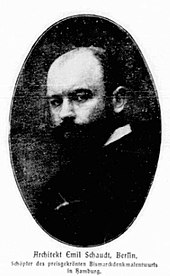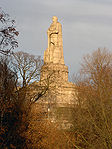Johann Emil Schaudt
Johann Emil Schaudt , also often Emil Schaudt , (born August 14, 1871 in Stuttgart , † April 6, 1957 in Berlin ) was a German architect who mainly designed commercial and administrative buildings.
Life
Schaudt studied architecture at the Technical University of Stuttgart and at the Technical University of Vienna . He then worked in the office of Skjøld Neckelmann in Stuttgart as well as with Ernst von Ihne and Paul Wallot , two of the most famous German architects of that era. From 1901, Schaudt worked as an architect mainly in Berlin and Hamburg, where he designed numerous commercial buildings, traffic structures and administrative buildings, especially for the Boswau & Knauer construction company .
At first he orientated himself stylistically on historicism , as represented by Ihne and Wallot; With the establishment of the KaDeWe , Schaudt increasingly took over elements of the premodern architecture that had been emerging since the turn of the century . Coming from a three-dimensional design, he reduced his formal language to an objective neoclassicism .
Schaudt had been a member of the Association of German Architects (BDA) since 1919 at the latest .
buildings
- Around 1900: Concert and dance hall "Groß-Berlin" in Berlin-Mitte, Jägerstraße 63a (destroyed by the war)
- 1905–1906: Bismarck Memorial in Hamburg (together with the sculptor Hugo Lederer )
- 1906–1907: Industrial Palace Warschauer Strasse in Berlin-Friedrichshain
- 1906–1907: Kaufhaus des Westens (“KaDeWe”) for Adolf Jandorf & Co. in Berlin, Wittenbergplatz / Tauentzienstrasse (1929–1930 rebuilt and expanded by Schaudt and Ströming)
- 1908–1909: Meyerhof office building in Berlin-Mitte, Schützenstrasse 15–17 (destroyed in the war)
- 1908–1909: Administration building for the North German Insurance Company in Hamburg, Alter Wall 12 (together with Emil Janda)
- 1909–1910: Kontorhaus in Hamburg, Alter Wall 10 (together with Walther Puritz)
- 1909–1910: Bierhaus Siechen in Berlin-Mitte , Potsdamer Platz (together with Paul Zimmerreimer )
- 1910: Rathaus Schöneberg underground station in Berlin-Schöneberg
- 1910–1911: Curiohaus residential and commercial building in Hamburg, Rothenbaumchaussee (together with Walter Puritz)
- 1910–1912: “Hafentor” (later “ Landungsbrücken ”) station of the Hamburger Hochbahn in Hamburg-St. Pauli (destroyed in the war)
- 1910: Remodeling and restoration of Storkow Castle
- 1911–1912: Residential and commercial building at Leipziger Strasse 33–35 / Charlottenstrasse 68 and Krausenstrasse 65/66 in Berlin-Mitte (interior work by Otto Schulze-Kolbitz; destroyed in the war)
- 1913–1914: “Handelshaus Hermes” office and commercial building (today “Haus Dorotheenstadt”) in Berlin-Mitte, Universitätsstrasse
- 1914–1915: Office and commercial building "Haus Kaisereck" or "Haus Kurfürsteneck" (also "Seidenhaus Michels" or "Michels-Haus") in Berlin, Kurfürstendamm / Rankestrasse
- 1927–1928: Excelsiorbad in the Hotel Excelsior in Berlin, Anhalter Straße 6 (destroyed by the war)
- 1928–1929: Administration building of the "Deutscher Herold" Volks- und Lebensversicherungs-AG in Berlin-Kreuzberg , Friedrichstrasse and Puttkamerstrasse
- 1928–1929: Administration building of the employees' union (GDA) in Berlin-Tiergarten , Am Karlsbad
- 1929: own house with studio in Berlin-Westend , Ahornallee
- 1929: Department store for H. & C. Tietz AG in Berlin-Wedding , Chausseestrasse
- 1930–1931: Office and commercial building for Salamander AG (called "Salamander high-rise") in Berlin, König - now Rathausstrasse (destroyed by the war)
- 1938–1940: Building of the Royal Danish Embassy in Berlin
gallery
Bismarck monument in Hamburg, 1906
Department Store of the West in Berlin, 1907
Danish embassy in Berlin, 1938
literature
- Max Osborn: Emil Schaudt. (= Modern designs: monthly booklets for architecture and spatial art ). Julius Hoffmann Verlag, Stuttgart 6.1907, p. 473 ff.
- Max Osborn : Johann Emil Schaudt, architect BDA. (= New Art of Work ). FE Hübsch, Berlin / Leipzig / Vienna 1931. (Reprint: Gebr. Mann, Berlin 1996, ISBN 3-7861-1831-0 ).
- Nikolaus Bernau: a forgotten architect . In: Berliner Zeitung . February 27, 2007.
Web links
- Kathrin Chod, Herbert Schwenk, Hainer Weisspflug: Schaudt, Johann Emil . In: Hans-Jürgen Mende , Kurt Wernicke (ed.): Berliner Bezirkslexikon, Mitte . Luisenstadt educational association . Haude and Spener / Edition Luisenstadt, Berlin 2003, ISBN 3-89542-111-1 ( luise-berlin.de - as of October 7, 2009).
- Information and photos about the Rathaus Schöneberg underground station. untergrundbahn.de
- Works by Johann Emil Schaudt. Digital collections of the Stuttgart University Library
Individual evidence
- ↑ Kathrin Chod: Industriepalast Warschauer Strasse . In: Hans-Jürgen Mende , Kurt Wernicke (Hrsg.): Berliner Bezirkslexikon, Friedrichshain-Kreuzberg . Luisenstadt educational association . tape 1 : A to O . Haude and Spener / Edition Luisenstadt, Berlin 2002, ISBN 3-89542-122-7 ( luise-berlin.de - as of October 7, 2009).
- ↑ a b List of monuments according to § 6 paragraph 1 Hamburg Monument Protection Act of April 5, 2013, Hamburg-Mitte (PDF; 1.72 MB)
- ^ Rolf Lange: Architecture Guide Hamburg. Edition Axel Menges, Stuttgart 1995, ISBN 3-930698-58-7 . ( limited preview on Google Books )
- ^ Karl-Heinz Arnold: Burned splendor at the Anhalter Bahnhof . In: Berlin monthly magazine ( Luisenstädtischer Bildungsverein ) . Issue 5, 1999, ISSN 0944-5560 , p. 25–31 ( luise-berlin.de - here p. 27).
- ↑ https://berlin-mitte-archiv.com/?36949198981710007605
| personal data | |
|---|---|
| SURNAME | Schaudt, Johann Emil |
| ALTERNATIVE NAMES | Shudder, Emil |
| BRIEF DESCRIPTION | German architect |
| DATE OF BIRTH | August 14, 1871 |
| PLACE OF BIRTH | Stuttgart |
| DATE OF DEATH | April 6, 1957 |
| Place of death | Berlin |






